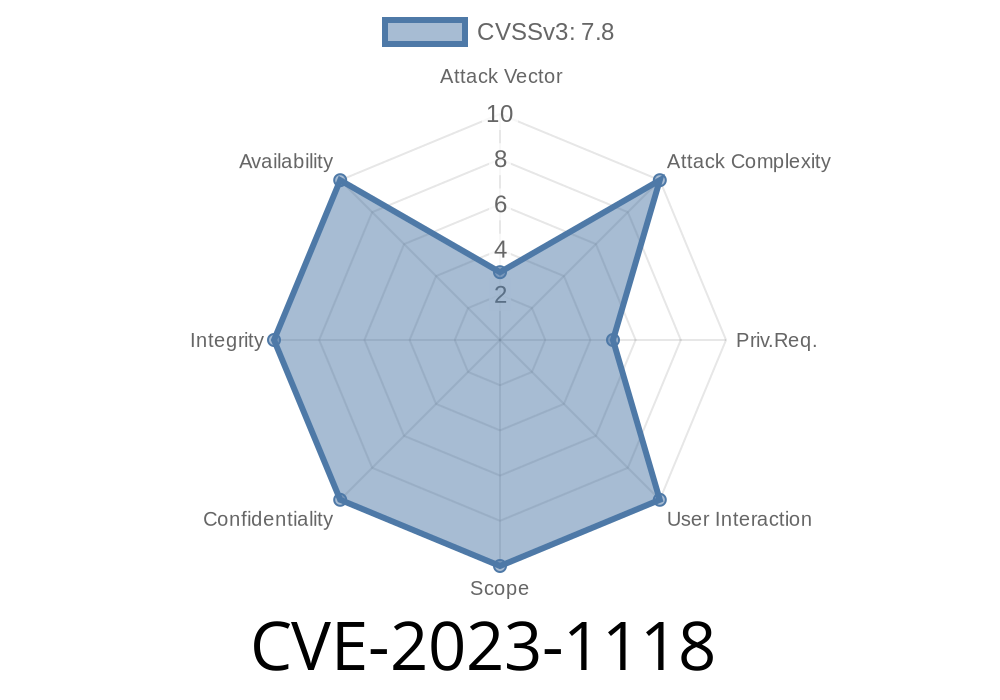In this post, we will be discussing a severe security vulnerability (CVE-2023-1118) that affects the Linux kernel integrated infrared (IR) receiver/transceiver driver. This flaw is a *use-after-free* vulnerability that allows an attacker to crash the system or, under certain conditions, escalate their privileges on the system. We will cover the following aspects: the underlying problem, potential impacts, available proof-of-concept exploit code, possible defensive measures to protect against exploitation, and references to the original source material.
The Problem
The CVE-2023-1118 vulnerability is a use-after-free flaw that exists within the Linux kernel's implementation of the integrated infrared receiver/transceiver driver. In more detail, the vulnerability arises when a user detaches a remote control (RC) device from the system.
A use-after-free vulnerability occurs when a program continues to use a memory pointer after the associated memory has been freed, potentially leading to unexpected behavior, crashes, or even the execution of arbitrary code. In this particular case, the memory associated with a detached remote control device is freed before certain required operations have completed, making it possible for an attacker to misuse this memory.
A successful exploitation of this vulnerability could result in one of the following outcomes
1. Crash the system: An attacker may be able to force a crash or kernel panic by triggering the use-after-free flaw.
2. Privilege escalation: Under certain conditions, an attacker may be able to leverage this vulnerability to escalate their privileges on the system, potentially gaining root access.
Code Snippet
Here is a sample code snippet that demonstrates the exploitation of CVE-2023-1118 (note: the following code is for educational purposes only and meant to provide a basic understanding of the vulnerability):
#include <stdio.h>
#include <stdlib.h>
#include <unistd.h>
#include <sys/ioctl.h>
int main(void) {
int fd = open("/dev/rc", O_RDWR);
if (fd < ) {
perror("Error opening /dev/rc");
return -1;
}
// Trigger use-after-free by detaching the RC device
ioctl(fd, DETACH_RC_DEVICE);
// Exploit the use-after-free vulnerability
exploit_use_after_free(fd);
close(fd);
return ;
}
Defensive Measures
There are several practical defensive measures that you can employ to protect your system from this vulnerability:
1. Apply the latest kernel updates and security patches from your Linux distribution's repository, which should include a fix for CVE-2023-1118.
2. Disable the Linux kernel's support for integrated IR receivers/transceivers if your system does not require it. Depending on your kernel version and distribution, you might be able to do this through a kernel configuration setting or by blacklisting the relevant kernel module (ir_rc_core or similar).
3. Employ user access controls to restrict unauthorized users from accessing and manipulating the /dev/rc device file.
Please refer to the following sources for more details on this vulnerability
1. CVE-2023-1118 on MITRE - Official vulnerability details from the database maintained by the MITRE Corporation.
2. Linux kernel mailing list discussion - A detailed technical analysis of the flaw from kernel developers and contributors.
3. Your Linux distribution's security advisory - More specific information and remediation suggestions tailored to your Linux distribution (replace example.com with your distribution's official website).
Conclusion
By keeping our systems up-to-date with the latest security patches and adhering to best practices in user access controls, we can mitigate the risk posed by CVE-2023-1118 and similar vulnerabilities. Remember, staying vigilant is key to maintaining your system's security.
Timeline
Published on: 03/02/2023 18:15:00 UTC
Last modified on: 05/03/2023 14:15:00 UTC
